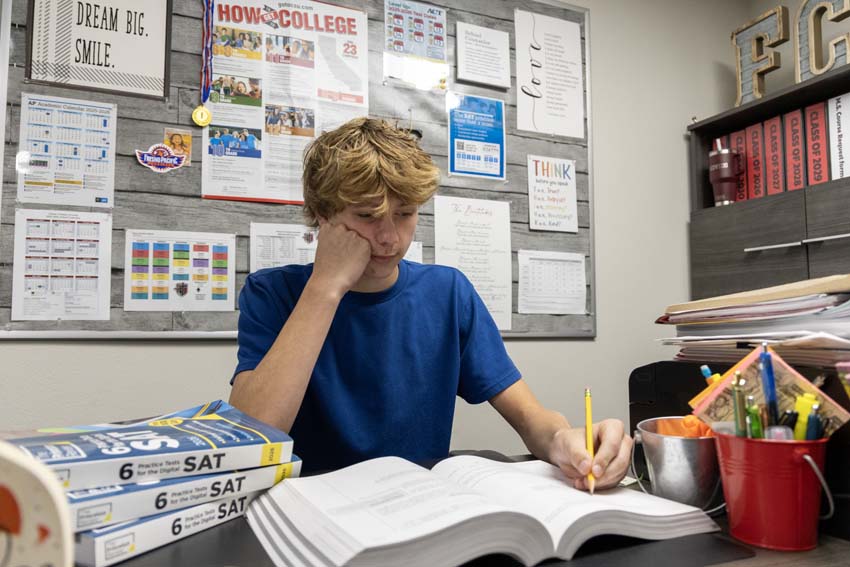Over exposure. Under exposure. F-stops. Panning. Aperture. Composition. Shutter. ISO. These words contribute to making up the extensive language of photography — a language I did not understand until taking lessons from professional photographer Tom Milne.
One day, as I sat in the computer lab editing photos, journalism adviser Greg Stobbe informed me that he had been in touch with Milne and arranged for me to visit his studio. The main goal was to help further my understanding of how a camera operates, information that I would then pass on to the student who will be taking my place as Photo Editor after I graduate.
To be honest, I was not too thrilled. I knew who Milne was considering he takes yearbook and team photos for our school every year, but I did not know him well enough to make hanging out with him for an hour on my Tuesday afternoon seem enjoyable.
However, after finding out that Milne’s lessons would be free of charge, I figured it would be wrong to let the opportunity pass by.
Although I did not know everything about the different camera settings, or what the “M”, “A”, “S”, and “P” stood for on the turn dial next to the flash, I didn’t think lessons were necessary. Up to that point, I knew enough about cameras to take photos I was satisfied with. I didn’t need lessons, right?
Wrong.
The first sentences Milne spoke to me when I stepped into his studio were, “Hi, nice to meet you,” “What kind of camera do you have with you?” and the dreaded question, “What is the lowest f-stop your camera goes to?”
Standing in the hallway, staring at him with a blank expression on my face and my eyes glazed over, the only thought running through my head was, What? F-stop? Uhhh… um… what?
He might as well have been speaking to me in Chinese or French, and even then I think I would have been able to understand those foreign languages more than Milne’s lingo. The first time he said “panning,” the first image that came to mind was a cooking pan. As he discussed the idea of “composition,” I could only think of those black and white composition notebooks teachers make their students use for journaling in class.
Needless to say, I didn’t know as much about photography as I thought I had. Through these simple questions, Milne helped me realize that right off the bat.
The photography lessons did not stop at just learning the technical terms. During the first visit, Milne taught me about depth of field and helped me understand f-stops and their significance. He assigned me specific projects to accomplish in a certain amount of time in his studio, and, after I was finished, we uploaded my pictures onto his computer to discuss what I had done right and what I had done wrong.
Before I knew it, one lesson turned into two lessons, and two lessons turned into five lessons. In a matter of two weeks, I learned that “panning” is not for cooking, but the technique of focusing on a subject in motion and moving the camera along with that subject in order to sharpen it while leaving the background blurred and out of focus.
I discovered that “composition” is not just a $.99 notebook you can buy at Savemart, but a term used to describe the basic rules and elements of photography, such as symmetry, texture, or depth of field.
I know that at a lower f-stop such as 3.5, more light is allowed into the optical lens in order to brighten a low-lit setting. In the same way, a higher f-stop lets less light in to balance the light in a higher-lit setting.
I think it is fair to say that, thanks to my lessons with Milne, I am bilingual. Photography lingo might not qualify as its own language, or count as my foreign language credits in order to graduate, but nonetheless it is a language I will use for the rest of my life.
Since my time with Milne, I have been asked to take wedding photos, I have doubled my clients for senior portraits and I have started to take family portraits. Ever since my last lesson at the studio, I have put everything I learned from Milne into practice, and, because of it, I have noticed a significant improvement in my work.
Tom Milne was gracious enough to allow me into his studio and patient enough to teach me the same techniques over and over again until I got it right. He helped shape me into a better photographer, one that not only knows how to take a good picture, but will never glaze over and think of cooking pans again when asked about technical settings.
For more information on Hannah Joseph’s photography, read the Oct. 11 article A novice among professionals: Debate experience or the Feb. 17 article Take three: Experiments in photography.






